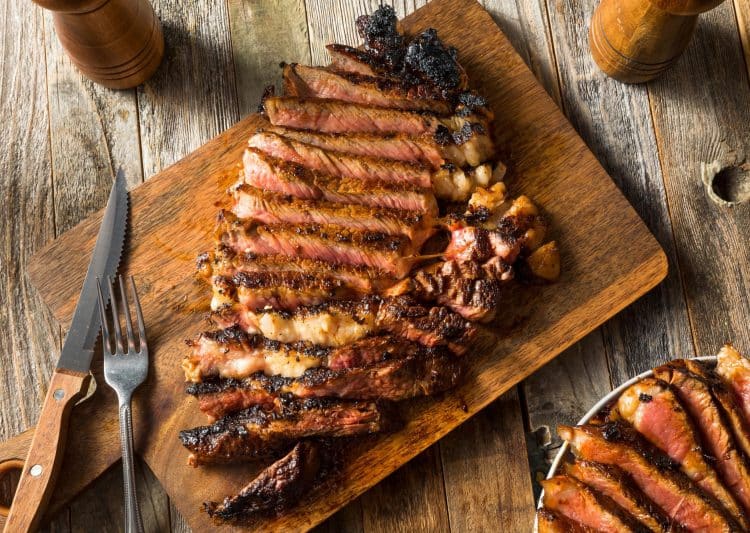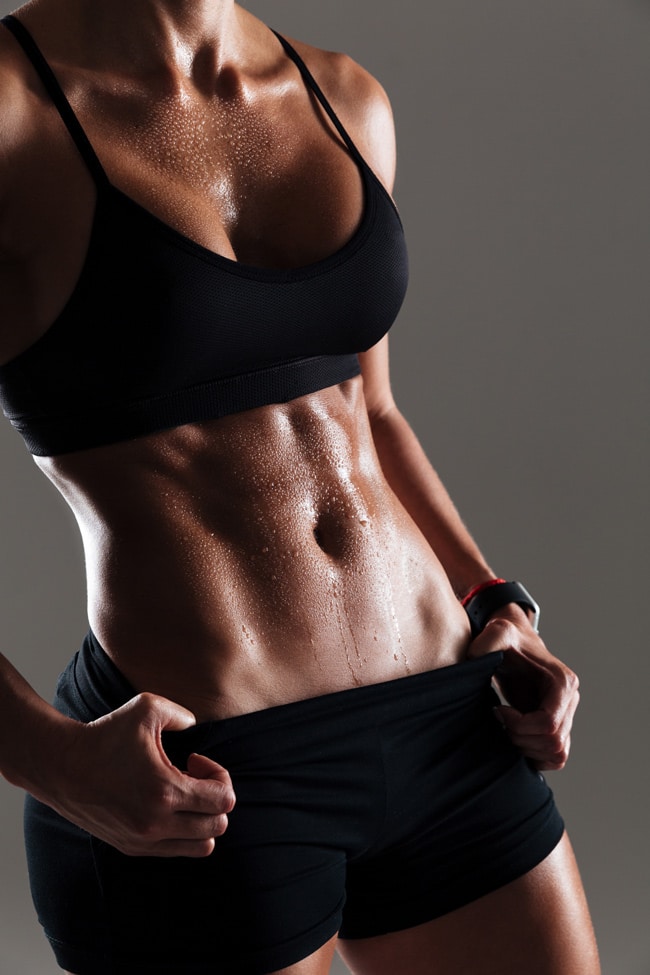Rewards drive humans. Most people start exercising to lose weight or build muscle mass. Gyms would turn into zombie lands if cardio and weight training didn’t cause weight loss, muscle or strength gains, or boost endurance and stamina. After all, no sane individual wants to feel out of breath, perspire profusely, or stay sore several days a month for no reason.
Many people stay away from working out because of their busy schedules. This excuse, however, rendered itself useless with the discovery of high-intensity interval training (HIIT). HIIT workouts last between 10 to 45 minutes and alternate short periods of intense exercise with even shorter recovery periods.
Studies reveal that although HIIT workouts might be short, they can deliver the same results as moderate-intensity workouts that are twice as long. [1]
This article discusses the scope of HIIT workouts, their types, and how long it takes to see HIIT results.
What are HIIT Workouts?
A HIIT workout can consist of a circuit of multiple exercises or alternate between periods of intense exercise and short recovery periods where you are at rest or performing the same exercise at a relatively low intensity.
Level Up Your Fitness: Join our 💪 strong community in Fitness Volt Newsletter. Get daily inspiration, expert-backed workouts, nutrition tips, the latest in strength sports, and the support you need to reach your goals. Subscribe for free!
Here are examples of both types of HIIT workouts:
HIIT Multi-Exercise Circuit
In a HIIT circuit, you’ll switch between multiple exercises. Given below is a 14-minute HIIT circuit. You’ll perform each exercise for 30 seconds and rest for 10 seconds after each exercise. Perform three rounds of this circuit. You are allowed a minute’s rest after completing each round.
- Burpee: 30 seconds
- Air Squat: 30 seconds
- Push-Up: 30 seconds
- Jumping Jacks: 30 seconds
- Box Jump: 30 seconds
- High Knees: 30 seconds
HIIT Single-Exercise Circuit
Single-exercise HIIT circuits are pretty straightforward. You alternate between performing an exercise and resting for a specified time.
Single-Exercise Circuit: Example 1
- Sprint at max speed on a treadmill: 1 minute
- Stand on the side rails: 30 seconds
- Repeat for 10 minutes
Single-Exercise Circuit: Example 2
- Sprint at max speed on a treadmill: 1 minute
- Walk/jog at half the speed: 30 seconds
- Repeat for 10 minutes
The high-intensity intervals of your HIIT routine should push your heart rate to 80-95 percent of your maximum heart rate. You could stop training during the resting period or perform the same activity at an intensity where your heart rate drops to 40-50 percent of the max.
Most training equipments have an in-built heart rate monitor. Alternatively, you could wear a chest band or a smartwatch to analyze your heart rate.
Benefits of HIIT Workouts
Below are the advantages of doing HIIT workouts:
Burn a Lot of Calories in a Short Period
HIIT workouts gained popularity because of their calorie-burning potential. A study found that 30 minutes of HIIT burns 25–30% more calories than a weight training, running, and biking session of the same duration. In this study, the participants alternated between 20 seconds of maximal effort and 40 seconds of rest. In other words, the HIIT group exercised for only one-third of the time compared to the running and biking groups. [2]
Weight Loss
HIIT workouts can help reduce body fat and waist circumference. It is most effective for overweight or obese people to shed excess weight. Considering its calorie-burning potential and short duration, HIIT sessions are a better option for people with busy schedules.
Improves Aerobic and Anaerobic Performance
HIIT workouts alternate between periods of all-out effort and moderate-intensity bouts. This combination helps improve your aerobic and anaerobic performance, which can be a boon for pro athletes and weekend warriors. Full-body high-intensity workouts can boost muscular and cardiovascular strength, endurance, and stamina. [3]
Boosts Your Metabolic Rate
A higher metabolic rate helps you burn calories even when you are sedentary hours after completing your workout. HIIT training is more effective than jogging or weight training at boosting your metabolic rate. Furthermore, high-intensity training shifts your body from using fat instead of carbs as its primary energy source. [4]
Helps Tones Muscles
Since HIIT workouts usually consist of full-body exercises, they can help build a toned physique. Although they are not as effective as traditional weight training regimens for building muscle mass, they can significantly improve your aesthetics.
Improves Oxygen Consumption
Oxygen consumption is your muscles’ ability to take in and use oxygen per minute. Factors like capillary density, mitochondrial density, and the volume of blood pumped by the heart determine your VO2 max.
HIIT is more effective at boosting your oxygen consumption than steady-state cardio. A study found that 20-minute HIIT workouts four days per week for five weeks improved the participants’ VO2 max by 9 percent. The other groups had to cycle continuously for 40 minutes per day, four days per week, to achieve the same results. [5]
Can Reduce Heart Rate and Blood Pressure
Unknown to most, HIIT can help reduce heart rate and blood pressure in overweight and obese people. Notably, HIIT exercise doesn’t change blood pressure in people in the normal BMI range who have normal blood pressure.
Factors Affecting the Speed of HIIT Results
Let’s say you and your training partner have learned everything there is to know about HIIT and have found a suitable training program; it still doesn’t guarantee that both of you will get the same results.
The speed of your HIIT results depends on multiple factors, including:
Workout Intensity
High intensity can mean different things to different people. Training at 70 percent of max heart rate might be high intensity for a beginner; an advanced trainer, however, might derive the same benefits from the workouts at 90 percent of max heart rate.
You must constantly evaluate your training intensity to get the best bang for your buck. Tally your training results with your peers or have a coach assess your training protocol. Low-intensity workouts delay your results and can also lead you to a plateau.
Bodyweight workouts, Tabata, plyometrics, cardio equipment-only, and weight training routines have different training intensities. You must cycle between these to constantly challenge yourself.
Training Frequency
Different people have different priorities. If you train three days a week, you shouldn’t expect the same results as an exerciser who crushes it six days a week in the gym. Your training frequency should depend on your training experience.
Recovery
Although training frequency is vital for getting better results from HIIT workouts, you shouldn’t overlook your recovery. Overtraining can negatively impact your central nervous system, impairing your body’s ability to repair and recuperate after workouts. You must strike a balance between training frequency and proper recovery programs.
Sleep seven to eight hours every night to give your body enough time to recover from your workouts. Feel free to tweak your rest time between HIIT circuits so your body has enough ATP reserves. Also, don’t shy away from skipping a workout if your body needs it. You must, however, be careful with your discretion on this subject.
Diet and Nutrition

Many people leave gains on the table because of a suboptimal diet program. You need to be on a calorie surplus to build muscle. On the other hand, a calorie deficit will help you shed excess weight.
Remember, you cannot out-train a bad diet. Cut out junk food, alcohol, and refined carbs from your diet if you want quick weight loss results. Furthermore, ensure you follow an appropriate carb, protein, and fats split per your goals.
Level Up Your Fitness: Join our 💪 strong community in Fitness Volt Newsletter. Get daily inspiration, expert-backed workouts, nutrition tips, the latest in strength sports, and the support you need to reach your goals. Subscribe for free!
Your Current Fitness Levels
An individual starting on a 20 percent body fat will need more time to get to 10 percent body fat than a person at 15 percent. Your starting endurance, stamina, mobility, and training experience also dictate your HIIT results.
Age, Gender, and Genetics
Your age, sex, and genetic predisposition will also decide how long it will take to see results from HIIT workouts. A 20-year male mesomorph is in a better position to build muscle than a 45-year-old male ectomorph.
Comparing your results with other people without considering these factors can push you into a downward spiral. Speeding your HIIT results requires you to make changes to your lifestyle.
Average Time To See Results From HIIT Workouts
Now that you know the factors that influence your HIIT results, it’s time to talk about the average time you must wait to see desired results.
Ready?
Not so fast.
Different people perform HIIT workouts for varying results. Some engage in HIIT circuits for weight loss, others do them to improve their cardiovascular health, and the rest commit to it for toning their muscles. We’ll stick to these three objectives for the scope of this article.
How Long Does It Take To See Results From HIIT Workouts For Improved Cardiovascular Health
HIIT workouts can boost your cardiovascular fitness, VO2 max, and anaerobic threshold. Furthermore, it is a more potent training protocol for shedding excess body weight than low-intensity stead-state (LISS) cardio. [6]
On average, you will notice better cardiovascular endurance and stamina in 6-8 weeks after starting a HIIT workout regimen. Perform at least three 30-40 minute HIIT workouts weekly for improved cardiovascular performance. [7]
How Long Does It Take To See Results From HIIT Workouts For Weight Loss
The majority engage in HIIT workouts to lose excess body fat. To shed weight, you must be in a calorie deficit. You cannot get rid of the spare tire by eating more calories than you expend in a day. Since HIIT workouts are more effective at burning calories than LISS cardio workouts, they are better suited for weight loss.
To determine your average daily calorie intake, use a calorie-tracking app like MyFitnessPal. Log in your meals for the last five to seven days and calculate your average daily calorie intake. Now, deduct 500 calories from your daily average and adjust your meals accordingly. Cutting 500 calories from your diet will help you lose 0.5-1 pound every week.
Follow this calorie deficit until you reach your desired weight. Then, bump up your calorie intake slowly to enter the maintenance phase.
You must wait approximately 8-12 weeks while staying in a calorie deficit and following a HIIT training program to see the needle budge in the right direction.
Track your weight loss progress weekly and adjust your calorie deficit based on your results. Steepen the calorie deficit if you are unsatisfied with your weight loss progress. You must, however, wait for at least 12 weeks before bumping up your calorie intake to enter the maintenance phase.
How Long Does It Take To See Results From HIIT Workouts For Toning Your Muscles
Many people confuse HIIT workouts with hypertrophy training. Traditional weight training is recommended over HIIT workouts if your goal is to put on muscle mass. HIIT circuits, however, are incredibly effective at toning muscles.
You must switch to a calorie deficit or remain on maintenance calories to tone your muscles quickly. You could build toned muscles by opting for a calorie-surplus diet, but that will require more time.
On average, expect to spend 8-12 weeks on a HIIT training program if your goal is to tone your muscles.
Remember, this is just an average timeline. Your results will vary depending on the five factors listed in this article.
What Results Can You Expect To See After Six Weeks of HIIT Workouts?
You should experience a noticeable difference in your cardiovascular endurance and stamina after doing HIIT workouts for six months. Folks following a calorie-deficit diet will see a 3-6 pound weight drop.
What Results Can You Expect To See After 12 Weeks of HIIT Workouts?
Assuming that you are respecting all the five factors that can affect your HIIT results, you’ll see improvements on all three fronts — weight loss, cardiovascular endurance and stamina, and muscle toning — after 12 weeks.
The degree of your results will depend on your starting condition and the severity of your calorie deficit, training intensity and frequency, and diet. You can expect to lose 6-12 pounds in these 12 weeks and might want to switch to a calorie maintenance phase.
Tracking Your HIIT Workout Results
You must constantly track your progress to ensure you are on the right path. Here are a few ways to log your improvements:
- Body measurements: Measure your chest, waist, arms, and thigh circumference.
- Photos: Click photos from the front, sides, and back.
- Weigh yourself: Recording your weight is one of the best ways to check your progress.
- Monitoring heart rate: A fitness tracker can help you with this.
- Keep a journal: Note down your mood and how you feel in a journal daily.
Besides keeping a daily journal, you don’t need to track the other three parameters every day. Take your body measurements and photos, and step on the scale once a week. Your fitness tracker will automatically monitor your heart rate pattern, so you don’t need to do anything on this front.
Assess your progress each week and ensure you are heading toward your goal. Make necessary adjustments every week if you feel you are deviating from your objectives or need to speed up your progress.
You can keep yourself accountable by sharing your progress and goals with your friends, family, coach, or online. This can also motivate you and ensure you don’t fall off the bandwagon.
Frequently Asked Questions
How often should I do HIIT for the best results?
You should do HIIT workouts at least 20 minutes daily, three times a week, to ensure progress. Training six days a week is optimal if you can also balance your diet and recovery programs. Switch between different HIIT workouts so that you don’t hit a plateau.
How do you know if your HIIT workouts are working?
You’ll notice an improvement in your cardiovascular stamina and endurance, weight loss, and physique aesthetics in eight weeks if you are following an effective HIIT exercise program. Alternatively, you can track your body measurements, photos, weight, and heart rate to check your progress.
Should I do fasted HIIT workouts for better results?
This depends on your personal preferences. Fasted cardio-based HIIT workouts might be effective if your goal is to lose weight. You should, however, eat a meal at least two hours before your workout if you want to boost your cardiovascular capabilities or improve your aesthetics.
Wrapping Up
Your HIIT workout results will depend on your training frequency, intensity, age, gender, genetics, current fitness levels, and diet and recovery program. Cardiovascular health improvements should become evident within six weeks of starting a HIIT workout regimen, whereas weight loss and muscle toning can take between 8-12 weeks.
Although it might sound like a lot, the results are well worth it. Stay patient and consistent with your efforts, and the results will follow. Best of luck!
References
- Kong Z, Fan X, Sun S, Song L, Shi Q, Nie J. Comparison of High-Intensity Interval Training and Moderate-to-Vigorous Continuous Training for Cardiometabolic Health and Exercise Enjoyment in Obese Young Women: A Randomized Controlled Trial. PLoS One. 2016 Jul 1;11(7):e0158589. doi: 10.1371/journal.pone.0158589. PMID: 27368057; PMCID: PMC4930190.
- Falcone PH, Tai CY, Carson LR, Joy JM, Mosman MM, McCann TR, Crona KP, Kim MP, Moon JR. Caloric expenditure of aerobic, resistance, or combined high-intensity interval training using a hydraulic resistance system in healthy men. J Strength Cond Res. 2015 Mar;29(3):779-85. doi: 10.1519/JSC.0000000000000661. PMID: 25162652.
- Ouerghi N, Fradj MKB, Bezrati I, Khammassi M, Feki M, Kaabachi N, Bouassida A. Effects of high-intensity interval training on body composition, aerobic and anaerobic performance and plasma lipids in overweight/obese and normal-weight young men. Biol Sport. 2017 Dec;34(4):385-392. doi: 10.5114/biolsport.2017.69827. Epub 2017 Sep 20. PMID: 29472742; PMCID: PMC5819474.
- Wingfield HL, Smith-Ryan AE, Melvin MN, Roelofs EJ, Trexler ET, Hackney AC, Weaver MA, Ryan ED. The acute effect of exercise modality and nutrition manipulations on post-exercise resting energy expenditure and respiratory exchange ratio in women: a randomized trial. Sports Med Open. 2015 Dec;1(1):11. doi: 10.1186/s40798-015-0010-3. Epub 2015 Jun 5. PMID: 27747847.
- Kong Z, Fan X, Sun S, Song L, Shi Q, Nie J. Comparison of High-Intensity Interval Training and Moderate-to-Vigorous Continuous Training for Cardiometabolic Health and Exercise Enjoyment in Obese Young Women: A Randomized Controlled Trial. PLoS One. 2016 Jul 1;11(7):e0158589. doi: 10.1371/journal.pone.0158589. PMID: 27368057; PMCID: PMC4930190.
- Schoenfeld, Brad CSCS1; Dawes, Jay MS, CSCS*D, NSCA-CPT*D2. High-Intensity Interval Training: Applications for General Fitness Training. Strength and Conditioning Journal 31(6):p 44-46, December 2009. | DOI: 10.1519/SSC.0b013e3181c2a844
- Garzon, R. (2018). Why and How to Do Aerobic Training, Including High-intensity Interval Training. COLLEGE OF AGRICULTURAL, CONSUMER AND ENVIRONMENTAL SCIENCES. https://doi.org/aces.nmsu.edu/pubs













